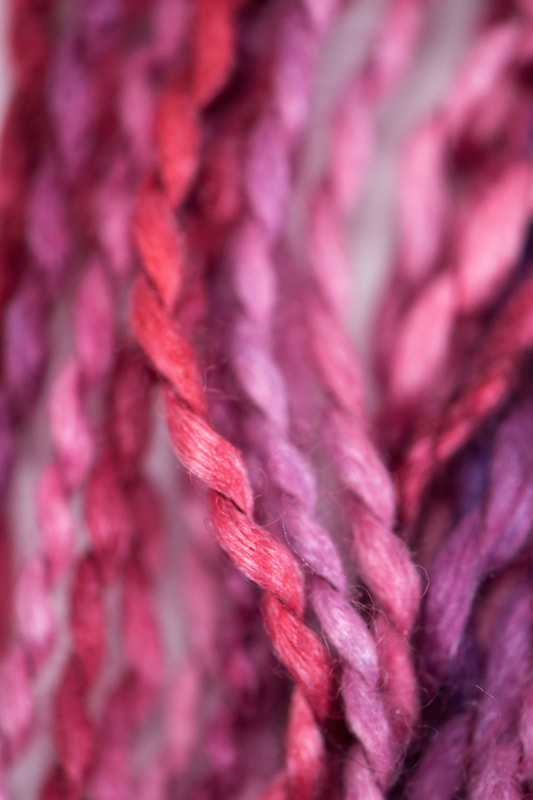|
Last fall, we moved across the country and into a new house. This was a huge shakeup! One of the things I needed was a new laundry basket to fit a dark and awkward corner in our bathroom. The Starting Point - A "Sad Greige" Laundry BasketI ended up buying this laundry basket at Target. The size was just right, but the gray fabric just made me sad. Right now gray walls are everywhere, but we decided to paint the house in more cheerful colors - peach, turquoise, and a very pale pink. So gray just wouldn't do. Luckily, I'm a weaver! I set out to weave a fabric that would go with our new color scheme, and brighten up that dark corner in the bathroom.
Have you heard of differential shrinkage? It's a scary-sounding word, and googling it doesn't help - you get a very technical description of building construction principles. Yuck! In weaving, differential shrinkage is actually a very simple idea. It means that some fibers shrink more than others when you wash them. And you can use that idea to create interesting textural effects in your woven fabric. Combining a shrinking fiber like wool with a non-shrinking fiber like silk or cotton in a single piece of fabric can create interesting results. When the fabric is washed, the shrinking fiber will pull the non-shrinking fiber into puffs. The looser and more open the fabric is, the more susceptible it will be to this effect because the fibers have more room to move around. The tighter the fabric is, the less it will be able to shrink because the fibers are already very close to each other. The first key to working with differential shrinkage is knowing which fibers will shrink and which won't. Wool is the most notable fiber that shrinks because it has scales that act like Velcro. Wool felts or fulls as heat, moisture, and agitation are applied to it. Some wools will shrink more than others - wool from Merino sheep felts easily, while wool from Southdown sheep is more resistant to felting. I've also included Lycra and elastic in the list of fibers that shrink because when they are on the loom, they are stretched out to their longest length, and when they are taken off the loom, they can shrink, creating textured effects. Subjecting them to heat will make them shrink more - think of stretch denim that has gone through the dryer one time too many! Fibers that Shrink:
Plant-based fibers don't shrink as much as wool because they lack the scales that cause wool to felt. Some animal fibers, like silk and mohair, don't shrink either. And many synthetic fibers like rayon, polyester, and tencel don't shrink. Some wools have been through a process called "superwashing," which either removes the scales from wool or smooths them down. These wools won't shrink as much, but I do find that they can shrink up to 10%, especially if they are subjected to very hot water or put in the dryer. Fibers that Don't Shrink (as much):
Sometimes we achieve differential shrinkage on purpose, and sometimes it's an accident. I've woven pieces where I used all wool, but the wool was all different breeds and/or brands of yarn that were spun differently. The differences in the wools and yarns meant that some shrank more than others. What I thought would be a basic striped rug was a wavy, rumply thing that would never lie flat. Other times, I've woven things where I combined different fibers on purpose, knowing I would get a textured effect. The weaving in the top image is one example - the warp was cotton, and the weft was a combination of cotton and a wool/silk yarn. Of these three fibers, wool is the only fiber that will shrink substantially. On the loom, the cloth looked flat. But after a trip through the washing machine on the delicate cycle, I ended up with a boucle-like fabric. That's differential shrinkage in action! There are lots of different textural effects you can achieve with differential shrinkage. You can create a fabric with allover texture, like I've done here, or you can create small areas of texture within a bigger piece of fabric. The possibilities are endless! Textural Effects You Can Achieve with Differential Shrinkage Not a weaver? You can also use differential shrinkage in crafts besides weaving. If you're a spinner, you can ply a shrinking fiber with a non-shrinking fiber. I love to use plying silk, which is very fine, to create a textured effect in my plied yarn. When you wet finish your yarn, you can full the shrinking fibers to create a textural effect. Maggie Casey of Shuttles, Spindles, and Skeins calls this "Boucle the Easy Way." If you're a knitter, you can use differential shrinkage in felting bags, hats, purses, and other items. If you're a felter, you can add effects with non-shrinking fibers to create dimensionality. You can also use different thicknesses of wool layers to create puckers and bubbles - this video gives a great overview of the how and why. Lately, I've been using differential shrinkage most often in creating boucle-like fabrics like the one pictured at the top of this post and my autumn leaves ruana. It really is a fun effect! |
Archives
January 2024
Categories
All
This website uses marketing and tracking technologies. Opting out of this will opt you out of all cookies, except for those needed to run the website. Note that some products may not work as well without tracking cookies. Opt Out of Cookies |



 RSS Feed
RSS Feed